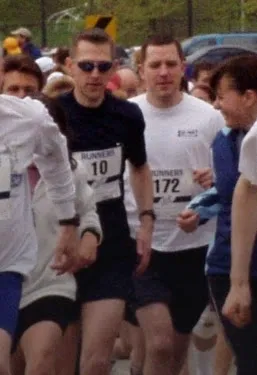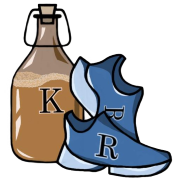
Back in early 2004, after I had about a year of running under my belt, I set my sights on a bold running goal: breaking 20 minutes in the 5K. But there was another motivation fueling me—beating my younger brother in the process. I circled May 8th on the calendar, the date of the Apple Blossom 5K in Bartlett, Illinois. It would be my second-ever race, and I was determined to make it a breakthrough performance.
A Rivalry for the Ages
Growing up, my brother and I had always been competitive, but we had our own athletic niches. While I leaned toward tennis and marching band, he excelled at baseball, basketball, and, most impressively, running. His high school PRs were on another level: 4:24 in the mile, 9:28 for two miles, and a blistering 15:30 5K. Even though 12 years had passed since his high school racing days, I knew if he took my challenge seriously, he’d bring his speed back in no time.
The Breaking 20 Training Plan
We both signed up for the May race and started training in February, each doing our own thing. But we had one shared ritual: a 5K time trial every Saturday to gauge progress. This became our speedwork and our way of sizing each other up without ever running together.
Winters in Chicago are brutal, so our time trials happened on treadmills. I had just bought my first treadmill, while my brother trained at Life Time Fitness. In *Runner’s World* I had read that to mimic outdoor conditions, you should set the treadmill incline to 1.5%. I made sure to do this for every run, sticking to the advice like gospel.
Week after week, we chipped away at our times. Every Saturday, I improved by about 30 seconds—but no matter how much I dropped my time, my brother stayed exactly one minute ahead of me. It was eerily consistent, but I kept my focus on my real goal: going sub-20. The week before the race, I clocked a time trial breaking 20 minutes, and—predictably—my brother was still one minute faster. The real test, though, would be race day.
Race Day: The Plan and the Reality
May 8th arrived with near-perfect weather: 50s, sunny, and a light breeze. Without a GPS watch (this was 2004, after all), I relied on the course’s mile markers and clocks to gauge my pace. My plan was simple: start slightly faster than goal pace (6:27 per mile), ease up a little in the second mile, then push hard to the finish.

As the gun went off, adrenaline took over. I fell right into stride with my brother. But something felt off—I had a pit in my stomach, a silent warning that I was moving too fast. Sure enough, we hit the first mile marker in **5:50**—way too aggressive. I knew I had to dial it back if I wanted any shot at finishing strong.
As I eased up slightly in the second mile, I realized my brother had faded behind me. I resisted the urge to look back, assuming he was lurking, waiting to surge. The second mile clock read **12:50**—a much slower 7:00 split, but I was still on track to breaking 20 minutes. The final push would decide everything.
The Final Stretch
The third mile was all about mental toughness. I ran as if my brother was breathing down my neck, waiting for his moment to pass me and have the last laugh. The discomfort from the first mile had subsided, and as I hit the home stretch, I emptied the tank.

The finish line clock came into view: **19:4X**. I pushed with everything I had and crossed in **19:49**—mission accomplished! I turned around, expecting to see my brother right behind me, but he was nowhere in sight.
A minute and a half later, he crossed the finish in just over 21 minutes. He had gone out hard too, but unlike me, he hadn’t been able to recover. I was thrilled to have broken 20, but I was also puzzled—how had I consistently trailed him by a full minute in training, only to beat him by 90 seconds on race day?
The Treadmill Revelation
After the race, I started piecing it together. When I asked my brother about his treadmill training, I discovered a crucial difference: while I had been running at a **1.5% incline**, he had been training at **0% incline**. That was it. The lack of simulated wind resistance had given him artificially faster times, while I had unknowingly prepped myself for the real-world demands of race day.
Lessons Learned in Breaking 20
– **Pacing is everything.** A 5:50 opening mile was too aggressive, but adjusting in mile two allowed me to finish strong.
– **Treadmill incline matters.** Setting it to at least 1% makes a real difference in translating fitness to outdoor races.
– **The mind is a powerful tool.** Imagining my brother surging behind me gave me the push I needed in the final mile.
I’ve never come close to the elite times my brother posted in his prime, but for one day in 2004, I ran faster than he did. More importantly, I achieved my goal—breaking 20 minutes in the 5K.
That race was a defining moment in my early running career, proving that smart training, mental toughness, and a little sibling rivalry can go a long way.

Leave a Reply
You must be logged in to post a comment.